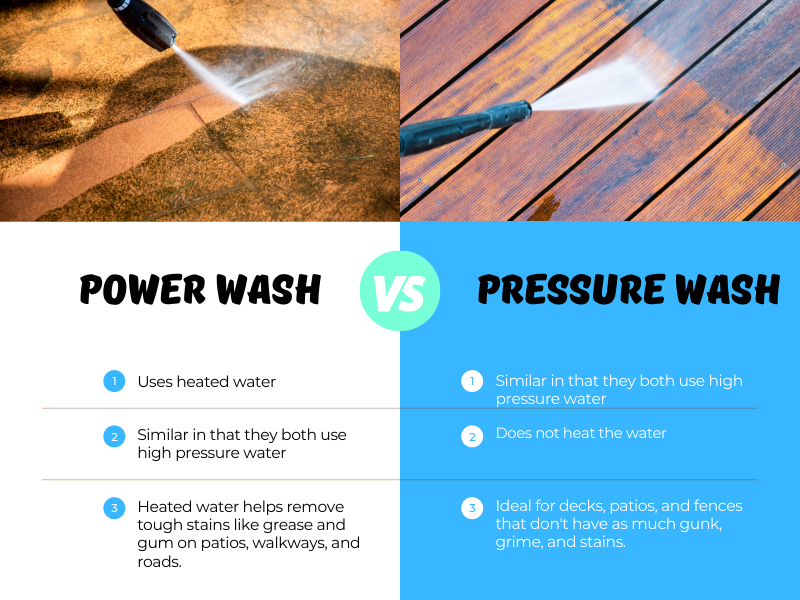When it comes to enhancing the beauty and longevity of your outdoor spaces, power washing emerges as one of the most powerful techniques. It can efficiently remove grime, debris, mold, and mildew, leaving surfaces looking new and refreshed. However, navigating the realm of pressure washing can seem intimidating for beginners. Whether you're looking to tackle a small weekend project or thinking about hiring professionals, understanding the do's and don'ts of pressure washing is crucial to achieve the best results without causing injury.
In this manual, we'll examine everything you need to know about pressure washing, from the advantages of enlisting professional help to the differences between pressure washing and soft washing. You'll discover about the most effective practices for various surfaces, how to safeguard your property while cleaning, and the right tools and techniques to use for optimal effectiveness. Let's get started and discover how you can revitalize your outdoor spaces with assurance.
Comprehending Pressure Washing
Pressure cleaning is a strong cleaning method that employs high-pressure liquid to remove soil, grime, mold, and various impurities from different surfaces. It is often used on exteriors of houses, pathways, pavements, outdoor spaces, and retail spaces. As a beginner, it's important to grasp how pressure washing functions, the tools required, and the proper techniques to not damage surfaces while gaining a thorough clean.
One of the main advantages of pressure cleaning is its potential to revive surfaces to their original state, enhancing the general look of your property. It is especially useful for removing tough spots, like grease or fungus, and can help maintain the integrity of components like lumber or cement. By eliminating these elements, power washing can also stop further degradation and extend the duration of your external surfaces.
When thinking about power washing, it's vital to differentiate between power washing and gentle washing. While pressure cleaning uses high pressure liquid for solid surfaces, low-pressure washing utilizes low pressure liquid mixed with custom cleaning agents for fragile areas like overheads and painted surfaces. Understanding these differences and choosing the correct approach for each job will secure efficient cleaning without inflicting harm.
Choosing Between Do-It-Yourself and Expert Assistance
Regarding pressure washing, a primary decisions you'll face is if you should do it yourself or hire a professional service. DIY pressure washing can be an appealing option for property owners looking to be budget-conscious while also enjoying handling projects at home. A rental pressure washer is frequently obtained fairly inexpensively, and numerous online resources provide guidance on the methods required. However, without proper expertise and experience, you could risk damaging your property, resulting in costly repairs down the line.
On the other hand, professional pressure washing companies offer several benefits which may surpass the initial cost. These experts possess the appropriate equipment, knowledge, and experience to manage various surfaces securely and effectively. These professionals can assess your home's specific needs, making sure that the appropriate pressure and cleaning products are used to prevent damage. Additionally, experts can often finish the work faster and efficiently than a DIY effort, leaving you with more time to enjoy your revitalized outdoor space.
In the end, the decision of DIY and professional assistance will hinge on your confidence with the task and your budget. If https://valleywashpros.com/ have experience with pressure washing as well as the necessary tools, a DIY method may be satisfactory. However, if you are unsure and have bigger areas to clean, hiring a specialist can save you time and prevent potential damage, offering peace of mind and high-quality results.
Best Practices and Tips for Efficient Cleaning
As you preparing to pressure wash, always remember to begin by analyzing the site to be cleaned. Identify sections that need different methods, including concrete, wood, or roofing materials. Every surface will perform in different ways to pressure, so it’s essential to adapt your equipment and settings appropriately. Make sure to clear the area of furniture and other objects to avoid any damage and ensure a complete clean.
Utilizing the suitable cleaning solutions can significantly enhance the performance of your pressure washing. For example, if you are addressing mold and mildew, a formula specifically formulated for these problems can make a substantial difference. Don’t forget to follow the manufacturer's instructions for both the pressure washer and any cleaning solutions. Consider using eco-friendly options that minimize harm to nearby plants and wildlife and still providing outstanding results.
Following pressure washing, it's vital to maintain the cleanliness of your surfaces. Frequently inspect areas prone to dirt buildup, such as driveways and patios, and schedule cleanings accordingly. Moreover, sealing surfaces including driveways and decks after washing can protect them from subsequent stains and damage. Incorporating a routine maintenance schedule will ensure your outdoor spaces looking fresh and pleasing for years to come.

